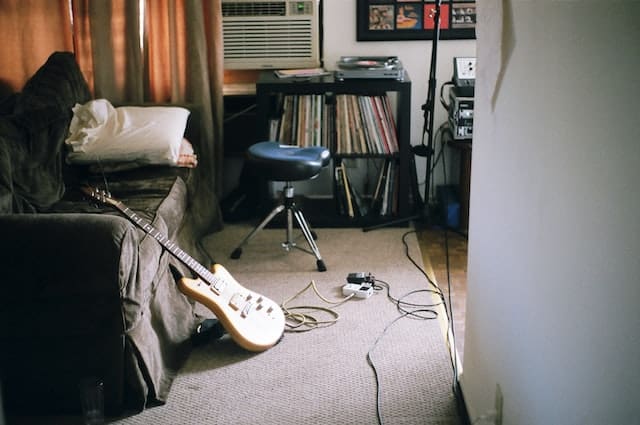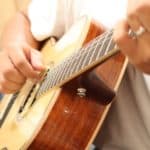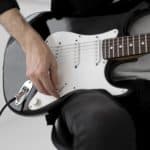Most people would agree that learning the guitar is a difficult undertaking, and as a beginner, it can be hard to know where to even start.
Today we’re going to look at how to learn guitar so that you can progress with as little difficulty as possible.
At the end of the day, there aren’t any secret tricks that will make you learn guitar fast.
There are however 4 principles that will make learning guitar easier for you though:
- Having a guitar that suits you
- Covering the basics
- Having a direction in mind
- Remaining diligent
Keeping these things in mind, you’ll be able to make progress on your guitar learning journey much better.
You will encounter difficulties, but that’s part of any journey to learn a new skill. So let’s look at making that journey more pleasant
How to pick a guitar as a beginner
There’s a lot to picking a guitar, but the main thing is to not get caught up in the fancy, shiny things. As a beginner, you’re going to want a guitar that you can basically play out of the box.
We’ll talk about price just now, but as far as guitar specs to look out for.
With acoustic guitars, you will benefit from a thicker neck at first, but that’s optional.
Other than that, there aren’t too many customizations to make to an acoustic guitar that will matter to a beginner. The shape also depends on preference and comfort.
With electric guitars, you will want to make sure you get a beginner-level guitar.
Some guitars, like the Floyd Rose bridge guitar, are a lot more complex and require personal customization and know-how.
A much more beginner-accessible guitar would be something like a simple Fender strat.
How much to spend on your first guitar
Going too cheap will just frustrate you down the line, but you also don’t want to go too expensive.
So what’s reasonable pricing?
Anything below $100 is likely to be junk and poorly made, and anything above $400 will only make you regretful if you decide that guitar playing isn’t for you.
Average prices for decent and well-known guitars:
Fender Strat
One thing you can do when buying your first guitar that will make it infinitely more enjoyable to play is to have it set up for you when you buy it.
You can usually find a luthier or guitar tech in the store that can set up your guitar for you. It will cost a bit extra, but it can make a $100 guitar feel like a $200 guitar.
Learn about the parts of the guitar
You’re going to need to learn about the different parts of the guitar and their functions as well as how to maintain them.
The parts of the guitar are as follows:
- The Body
- Neck
- Head
- Frets
- Bridge
- Bridge saddle
- Fretboard
- Tuning Pegs
- Truss rod
The main things you’ll need to focus on are the tuning pegs and the truss rod. The tuning pegs obviously keep your strings in tune.
The truss rod is a metal rod that runs through the neck of the guitar and is responsible for keeping the neck straight under the tension of the strings.
You can lengthen or shorten the rod to increase the action of the strings on your neck, which is the height the strings are from the fretboard.
This is important because it will affect how difficult or easy it is to play your guitar.
You should be careful when adjusting the truss rod because there is a method to it and
I’ve got a video link to show how to do it, but as a beginner, I’d recommend you ask a professional to adjust it for you.
If you do it yourself, there are two extremes to avoid:
If you set it to bow too far in and the strings are too high to play properly on the guitar.
This will hurt your fingers faster and make many things near impossible.
If you set the truss rod so the guitar bows backward, you will be able to press the strings down easily, but the strings will get caught on frets and you won’t get any sound.
Should you play with a pick or with your fingers?
It depends on your goals and style of guitar. If you want to play fingerstyle guitar, you should use your fingers.
If you want to play general guitar, you will need to learn to use a pick.
I would recommend learning both to a degree.
I play rock-style music a lot, which is best suited to a pick, but I like to use my fingers to do folk-type songs every now and then.
If you’re more into learning electric guitar, get used to using a pick.
How to read music for guitar
It’s pretty simple.
You can learn guitar using tabs.
The only thing I find beginners get confused with as far as reading tabs is that it’s upside-down reading.
I like to explain it like this:
if you lay your guitar face up on your lap and look down at the strings, playing the tabs is like looking at your guitar from that angle.
The top line is the thinnest string and the bottom line is the thickest string.
The numbers will represent frets, so that’s pretty straightforward.
Other than that, some symbols describe how you should play the note:
- / or \ shows to slide
- 2h3 or 3p2 shows to do a hammer-on or pull-off
- *, this symbol usually shows that a note should be played as a pinch harmonic
- A “.” or p.m below the staff in line with notes usually demonstrates that they should be muted
- “.” in classical music show that notes should be played in a staccato manner
Start with some basic guitar chords
Starting with basic chords is the quickest to start making something resembling music.
Here are some chords you can start learning as a beginner.
These chords above are called open chords because they leave some strings open.
They’re specifically chords in the key of C and G. You can try mixing and matching them, but you’ll need to practice switching between the chords too.
An important aspect of playing these chords is that they need to sound out clearly. The way to do this is to have good finger posture when playing.
You want to be pressing the strings on the tip of your fingers so that you don’t unintentionally mute any of the strings your fingers aren’t pressing.
Basic guitar strumming patterns
Once you can play some basic chords, you should learn to strum them to a rhythm. Here are some rhythms you can try.
When playing guitar rhythm, it’s important to strum according to the direction shown. That means you should play by strumming up AND down where indicated.
The reason for this is to build a sense of timing.
When you practice strumming, you should also use a metronome.
You can find a lot of free metronome apps online.
Can you learn guitar by yourself?
Definitely.
You can learn guitar by yourself if you want to, we even have an article on the best way to go about doing that.
I would recommend a teacher though if you’re looking to learn fast though.
A teacher will be able to use their experience to help you consistently achieve your guitar goals.
They can also help show you the bad habits to avoid while learning guitar.
This is a common problem for self-taught beginner players.
They tend to pick up a lot of bad habits if they aren’t diligent.
If that isn’t you though, if you can remain disciplined and diligent with yourself, you can definitely learn guitar on your own.
Here is an article you should check out about it:
Guitar practice routines
You’re going to need a guitar practice routine if you want to see any real progress in your guitar playing.
A lot of beginner guitar players put all their time into learning new songs, but the problem comes when you’re learning a new song and it has techniques in it that you haven’t mastered.
I have an article that goes over different routines for different levels but for beginners, it comes down to setting up a routine around the following:
- Good posture
- Good finger technique
- The basics of picking and pentatonic scale
- Working on hand synchronization
- Basic chord shapes and simple rhythm
That doesn’t mean you shouldn’t learn any songs while you’re a beginner, it just means to balance your time between learning songs and learning techniques.
If you encounter a technique you don’t know in a song, find out how it works and find exercises to work on it outside of the song.
Easy songs you can play right away
If you’re looking to learn songs to get the hang of guitar, you should look for a few things:
- Simple rhythm
- Simple melody
- Not too many strings involved in playing the melody
- Melody focused mainly on picking
You can try some of these basic songs to get started. I’ll link to some lessons:
Ode to Joy
Smoke on the water’s main riff
Seven nation army
Eye of the tiger
The Nutcracker
Open your eyes by Snow Patrol
How to get unstuck when you are learning guitar
Often people get stuck because they get too rote about their learning or they work themselves into a box about what is acceptable and what’s not.
At the core of it, music is about expression and experimentation.
In fact, I have a whole article about getting unstuck on guitar that goes more in-depth about it.
But, the main things to look out for:
- Deconstruct the songs you’ve been learning and see how they’re put together
- Listen to new music
- Learn a new lick and then try to apply It in different contexts, get really scientific about it.
- Don’t just play the same thing every time you pick up your guitar
- Play together with other musicians, it’s a great catalyst for learning.
That’s a very quick look at the top tips for quickly becoming unstuck as a guitar player.
That should cover everything that will help you learn guitar fast as a complete beginner.

Hello there, my name is Ramiro and I’ve been playing guitar for almost 20 years. I’m obsessed with everything gear-related and I thought it might be worth sharing it. From guitars, pedals, amps, and synths to studio gear and production tips, I hope you find what I post here useful, and I’ll try my best to keep it entertaining also.





